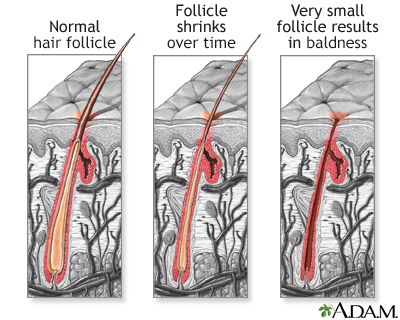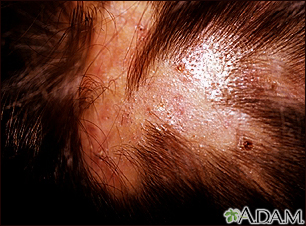Hair loss
Loss of hair; Alopecia; Baldness; Scarring alopecia; Non-scarring alopecia
Partial or complete loss of hair is called alopecia.
Images








Considerations
Hair loss usually develops gradually. It may be patchy or all over (diffuse). Normally, you lose roughly 100 hairs from your head every day. The scalp contains about 100,000 hairs.
Causes
HEREDITY
Both men and women tend to lose hair thickness and amount as they age. This type of baldness is not usually caused by a disease. It is related to aging, heredity, and changes in the hormone testosterone. Inherited, or pattern baldness, affects many more men than women. Male pattern baldness can occur at any time after puberty. About 80% of men show signs of male pattern baldness by age 70 years.
PHYSICAL OR EMOTIONAL STRESS
Physical or emotional stress may cause one half to three quarters of scalp hair to shed. This kind of hair loss is called telogen effluvium. Hair tends to come out in handfuls when you shampoo, comb, or run your hands through your hair. You may not notice this for weeks to months after the episode of stress. Hair shedding decreases over 6 to 8 months. Telogen effluvium is usually temporary. But it can become long-term (chronic).
Causes of this type of hair loss are:
- High fever or severe infection
- Childbirth
- Major surgery, major illness, sudden blood loss
- Severe emotional stress
- Crash diets, especially those that do not contain enough protein
- Drugs, including retinoids, birth control pills, beta-blockers, calcium channel blockers, certain antidepressants, NSAIDs (including ibuprofen)
Some women ages 30 to 60 years may notice a thinning of the hair that affects the entire scalp. The hair loss may be heavier at first, and then gradually slow or stop. There is no known cause for this type of telogen effluvium.
OTHER CAUSES
Other causes of hair loss, especially if it is in an unusual pattern, include:
- Alopecia areata (bald patches on the scalp, beard, and, possibly, eyebrows; eyelashes may fall out)
- Anemia
- Autoimmune conditions such as lupus
- Burns
- Certain infectious diseases such as syphilis
- Excessive shampooing and blow-drying
- Hormone changes
- Thyroid diseases
- Nervous habits such as continual hair pulling or scalp rubbing
- Radiation therapy
- Tinea capitis (ringworm of the scalp)
- Tumor of the ovary or adrenal glands
- Hair styles that put too much tension on the hair follicles
- Bacterial infections of the scalp
Home Care
Hair loss from menopause or childbirth often goes away after 6 months to 2 years.
For hair loss due to illness (such as fever), radiation therapy, medicine use, or other causes, no treatment is needed. Hair usually grows back when the illness ends or the therapy is finished. You may want to wear a wig, hat, or other covering until the hair grows back.
Hair weaves, hair pieces, or changes of hair style may disguise hair loss. This is generally the least expensive and safest approach to hair loss. Hair pieces should not be sutured (sewn) to the scalp because of the risk for scars and infection.
When to Contact a Medical Professional
Call your health care provider if you have any of the following:
- Losing hair in an unusual pattern
- Losing hair rapidly or at an early age (for example, in your teens or twenties)
- Pain or itching with the hair loss
- The skin on your scalp under the involved area is red, scaly, or otherwise abnormal
- Acne, facial hair, or an abnormal menstrual cycle
- You are a woman and have male pattern baldness
- Bald spots on your beard or eyebrows
- Weight gain or muscle weakness, intolerance to cold temperatures, or fatigue
- Areas of infection on your scalp
What to Expect at Your Office Visit
A careful medical history and examination of the hair and scalp are usually enough to diagnose the cause of your hair loss.
Your provider will ask detailed questions about:
- Symptoms of your hair loss. If there is a pattern to your hair loss or if you are losing hair from other parts of your body as well, if other family members have hair loss.
- How you care for your hair. How often you shampoo and blow dry or if you use hair products.
- Your emotional well-being and if you are under a lot of physical or emotional stress
- Your diet, if you have made recent changes
- Recent illnesses such as a high fever or any surgeries
Tests that may be performed (but are rarely needed) include:
- Blood tests to rule out disease
- Microscopic examination of a plucked hair
- Skin biopsy of the scalp
If you have ringworm on the scalp, you may be prescribed an antifungal shampoo and oral medicine for you to take. Applying creams and lotions may not get into the hair follicles to kill the fungus.
Your provider may advise you to use a solution, such as Minoxidil that is applied to the scalp to stimulate hair growth. Other medicines, such as hormones, may be prescribed to decrease hair loss and promote hair growth. Drugs such as finasteride and dutasteride can be taken by men to decrease hair loss and grow new hair.
If you have a certain vitamin deficiency, your provider will likely recommend that you take a supplement.
Hair transplant may also be recommended.
Related Information
Male pattern baldnessTestosterone
Female pattern baldness
References
Phillips TG, Slomiany WP, Allison R. Hair loss: common causes and treatment. Am Fam Physician. 2017;96(6):371-378. PMID: 28925637 pubmed.ncbi.nlm.nih.gov/28925637/.
Sperling LC, Sinclair RD, El Shabrawi-Caelen L. Alopecias. In: Bolognia JL, Schaffer JV, Cerroni L, eds. Dermatology. 4th ed. Philadelphia, PA: Elsevier; 2018:chap 69.
Tosti A. Diseases of hair and nails. In: Goldman L, Schafer AI, eds. Goldman-Cecil Medicine. 26th ed. Philadelphia, PA: Elsevier; 2020:chap 413.
BACK TO TOPReview Date: 6/7/2023
Reviewed By: Elika Hoss, MD, Assistant Professor of Dermatology, Mayo Clinic, Scottsdale, AZ. Also reviewed by David C. Dugdale, MD, Medical Director, Brenda Conaway, Editorial Director, and the A.D.A.M. Editorial team.

Health Content Provider
06/01/2025
|
A.D.A.M., Inc. is accredited by URAC, for Health Content Provider (www.urac.org). URAC's accreditation program is an independent audit to verify that A.D.A.M. follows rigorous standards of quality and accountability. A.D.A.M. is among the first to achieve this important distinction for online health information and services. Learn more about A.D.A.M.'s editorial policy, editorial process and privacy policy. A.D.A.M. is also a founding member of Hi-Ethics. This site complied with the HONcode standard for trustworthy health information from 1995 to 2022, after which HON (Health On the Net, a not-for-profit organization that promoted transparent and reliable health information online) was discontinued. |
The information provided herein should not be used during any medical emergency or for the diagnosis or treatment of any medical condition. A licensed medical professional should be consulted for diagnosis and treatment of any and all medical conditions. Links to other sites are provided for information only -- they do not constitute endorsements of those other sites. © 1997- 2025 A.D.A.M., a business unit of Ebix, Inc. Any duplication or distribution of the information contained herein is strictly prohibited.
